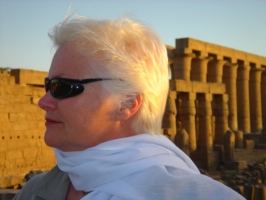It was supposed to be foggy and cloudy, but it was sunny. We were supposed to be tired, but we were energized. There was a transportation strike, but we were walking. These factors all made a perfect combination for a trek up la butte of Montmartre. I hadn’t realized we were walking up to the Montmartre’s old gypsum mines.
Walking straight north from the apartment, my friend and made our way to the old village of Montmartre, originally a Roman temple, then a Benedictine monastery. Montmartre is still the highest point (at 420 feet) in Paris and is topped by the Basilica of Sacre Couer (pictured below). Montmartre was its own village, separated from Paris by a wall, until 1860 when it was incorporated into the city.
Â
Montmartre used to have many gypsum mines. The gypsum was used in making plaster of Paris. This plaster got mixed into materials applied to building facades, and for making plaster casts of artwork and for setting broken bones.
Paris lies within the geological “Paris basin,” a bowl sculpted by millennia of sedimentary deposits and erosion. Upon a layer of chalk, Paris’s deposits were clay, limestone, sand, more limestone, and 3-4 bands of plaster (up to about 120 feet thick in places) separated by thin deposits of marl (called “sea chalk” in Europe). This is all capped with another layer of clay, and then more sand organic landfill on top. Thus Montmartre becomes “the butte.”
Along Rue de Cortot is the cozy little Montmartre Museum located in the oldest house in Montmartre. The museum’s displays of photographs, paintings, and cartoons of the earlier days of Montmartre were fascinating, including about eight photographs of gypsum mining on the butte. Donkeys were used to transport the rock and powder out of the mine to carts.
Plaster of Paris–calcium sulfate hemihydrate–is created by heating the gypsum, when the gypsum loses three-quarters of its water. The colorless powder is then mixed with water to form a workable paste. Since plaster expands while hardening and then contracts slightly just before it hardens completely, plaster of Paris is excellent for use in molds. Artists can also spread it over some kind of form–of wire, mesh or other materials–for building sculptures. I saw quite a few of these plaster casts and constructions in the Rodin Museum. Plaster is often used in “faux finishing” to create textures for walls and for creating facade decorations.
The gypsum mines themselves were shut down in the 1860s. Many of the old shafts were then used to house corpses, bodies from cholera epidemics and revolutionary battles. Montmartre has three such cemeteries. The mines also complicated building the huge basilica of Sacre Couer. Engineers had to sink 83 pillars 130 feet into th ground the keep the church stable.
I would love to have taken a Montmartre. gypsum mine tour. The donkeys, mine shafts, the workers, and the various uses of plaster seem to add up to some colorful ambience. Perhaps someone someday will figure out a way to open up this former Montmartre world to tourists.
After all, the old grapevines of Montmartre are still growing, thanks to a replanting project in 1933. Le Clos Montmartrevineyards are made up of 1,850 square yards of vine stock, (mostly Gamay and Pinot Noir) and produce a yearly total of about 1,700 half-liter bottles. There’s a harvest festival every year in October, Fête des Vendanges, which my son and his girlfriend happened upon after their tour of Champagne.
The authorities of Montmartre’s 18th arrondissement could offer tours of old gympsum mines, create a Montmartre Gypsum and Plaster Museum, offer donkey rides, and organize a plaster of Paris festival with contests in plaster molding, facade decoration, and casting. It could be fun and kitschy, educational and historic, artistic and crafty. I’d go, wouldn’t you?




2 Comments